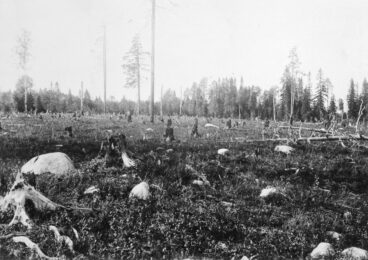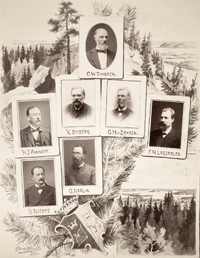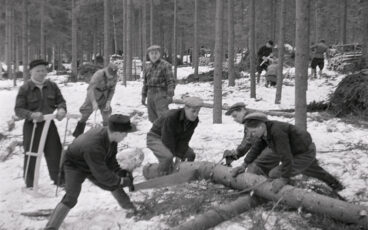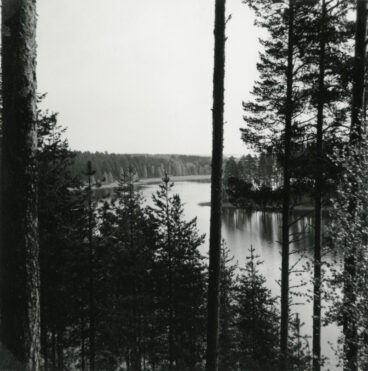Over 160 years of Metsähallitus history
State-owned lands have always been the focus of different and constantly changing expectations in Finland. As the steward of state-owned land, Metsähallitus has been a mirror of society, reflecting the attitudes and spirit of each era. In 2019, Metsähallitus celebrated its 160th anniversary. This is a concise account of how we got this far.

In 1542 Gustav Vasa, King of Sweden and Finland, declared that uninhabited wildernesses were the property of God, the King and the Crown. This marked the beginning of the state’s land ownership. Peasants had a right to use the wilderness areas, and the boundaries between privately owned and crown forests remained blurred for a long time.
Read more about state-owned land and water areas managed by Metsähallitus.

At the beginning of the 19th century, the Finnish forests were put to many uses, including slash-and-burn agriculture, tar production and, increasingly, the sawmill industry. Enough timber was cut down to raise concerns over deforestation among the authorities in Finland.
Read more about the history of forests on the website of the Finnish Forest Museum Lusto (lusto.fi).
In 1841 Russian Emperor Nicholas I, who ruled over Finland, appointed a committee to consider a reform of forest legislation. The proposal it produced was not to everybody’s liking; editor-in-chief and philosopher J.W. Snellman took particular exception to it and initiated a public debate with Professor Nordstöm, a member of the committee. One of the points at issue in the gentlemen’s debate was whether Finland should have forests at all, or whether they should all be felled.
“Where the forest prevails, misery, ignorance and brutality also hold sway.” J.W. Snellman
The proposal prepared by the committee was not passed; it was defeated by the dissenting opinion of a single man, Councillor L.G. von Haartman. The ‘Forest Programme’ proposed by him ultimately laid the foundation for the Forest Act.
“Nature has placed our only source of wealth, the source of our economic independence, in the forest.” L.G. von Haartman
Records of the country’s first forest dispute and many other events in our history have been preserved in the Finnish Forest Museum Lusto.

In 1851, a strict Forest Act was enacted, and a temporary National Board of Land Surveying and Forest Management was established to supervise compliance with the Act and to look after the state’s land assets. The history of Metsähallitus began in 1859, as Emperor Alexander II signed a declaration on the establishment of a Forest Management Institute. Its task was to manage and protect forests and generate revenue for the crown by selling timber.
Over the years, various forest administration reforms have changed Metsähallitus’ organisation and tasks. A decree issued in 1921 instated Metsähallitus as a central agency subordinate to the Ministry of Agriculture and Forestry, tasked to “manage, oversee and promote Finnish forestry”. This has remained the basic premise of our work until these days; however, Metsähallitus’ duties no longer extend to the private forestry sector.
Read more about Metsähallitus’ current tasks and management system.
The area of activity entrusted to the forest administration was the focus of many conflicting expectations. In addition to its basic task of managing and stewarding the state’s forest property, its duties included generating revenue for the state, supporting the growth of the sawmill industry, and promoting housing. Due to these partly conflicting interests, a triangle consisting of the state, the industry and the local population of the managed areas was formed around the forest administration, in which each corner was pulling in a different direction.
In the early years, timber trade did not produce the desired profits. The forest administration’s efforts to control state-owned forests resulted in repeated conflicts with the local population, who had become accustomed to making a living out of these areas. Most importantly, forest policy and housing policy were on a collision course. From all this, we have come a long way to reach today’s Metsähallitus.
Reconciling different needs remains a core task for Metsähallitus.

The Forest Management Institute, later known as Metsähallitus, has sold timber at auctions, by contract and to make way for railway lines; operated sawmills; served as a log storage facility and firewood office during the war; and organised working parties to fell trees in order to pay war reparations. Considerable amounts of wealth have been obtained from state forests to develop the welfare state. At the same time, forest industry training has been actively developed and the potential of forest management to improve the efficiency of timber production has been researched, while the area of protected forests has been expanded.
Read more about the history of forestry at Metsähallitus.

The first discussions on nature conservation in Finland started in the 1880s. Several proposals were made to establish nature parks in crown forests and later in state-owned forests. The proposals were justified by aesthetic, tourism-related and scientific arguments alike. While the progress in establishing actual conservation areas was slow, in the early 20th century Metsähallitus took the initiative to protect some of its forest areas regarded as valuable. Nature conservation became a statutory obligation in 1923, and the first national parks were officially inaugurated in 1938.
Today, 19% of the areas managed by Metsähallitus are statutory nature reserves, while 4% are included in different conservation programmes. The total share of wilderness areas and other special areas is 23%. We take pride in promoting nature conservation, forest biodiversity and a balanced relationship between humans and nature.
Read more about the development of nature conservation and recreational services.